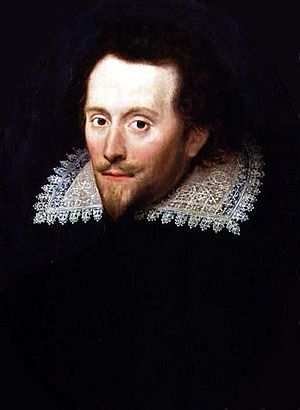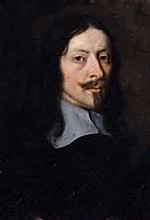William Cavendish, 1st Duke of Newcastle facts for kids
Quick facts for kids
The Duke of Newcastle upon Tyne
|
|
|---|---|

Portrait by William Larkin, c. 1610
|
|
| Lord Lieutenant of Nottinghamshire | |
| In office 1660–1676 |
|
| Lord Lieutenant of Derbyshire | |
| In office 1628–1638 |
|
| MP for East Retford | |
| In office 1614–1620 |
|
| Personal details | |
| Born | c. 16 December 1593 Handsworth, South Yorkshire, England |
| Died | 25 December 1676 (aged 83) Welbeck, Nottinghamshire, England |
| Resting place | Westminster Abbey |
| Spouses | Elizabeth Howard (1599–1643) Margaret Lucas (1623–1673) |
| Relations | William, Earl of Devonshire (1590–1628) Sir Charles Cavendish (1594–1654) |
| Children | Jane (1621–1669), Charles (1626–1659) Elizabeth (1626–1663) Henry, 2nd Duke of Newcastle (1630–1691), Frances |
| Parents | Sir Charles and Lady Catherine Cavendish |
| Alma mater | St John's College, Cambridge |
| Occupation | Courtier, arts patron, soldier |
| Military service | |
| Allegiance | |
| Years of service | 1642—1644 |
| Rank | Captain-General |
| Commands | Royalist commander for the North |
| Battles/wars | |
William Cavendish, 1st Duke of Newcastle upon Tyne (born around 1593, died 1676), was an important English nobleman. He was known for supporting the arts and for his love of horses. He even called himself "Prince William Cavendish" after 1665.
William Cavendish was a famous horse breeder. He also supported writers like Ben Jonson and a group of thinkers called the Welbeck Circle.
He spent a huge amount of money, about £15,000, to entertain King Charles I in 1634. However, he didn't get a major political job. When the First English Civil War started, he became a top commander for the King's side (the Royalists) in Northern England. He paid for much of the war effort himself, claiming it cost him over £1,000,000.
After a big defeat at the Battle of Marston Moor in July 1644, which he had advised against, he went to live in Europe. He came back to England in 1660 when the King returned to power. He became the Duke of Newcastle in 1665. He died in 1676 and was buried in Westminster Abbey.
Contents
William's Early Life and Family
William Cavendish was born in Handsworth, South Yorkshire. He was the oldest son of Sir Charles Cavendish and Catherine Ogle. His grandmother was Bess of Hardwick, a very famous and wealthy woman. He had a younger brother named Charles, and they were very close friends.
In 1618, William married Elizabeth Howard. They had five children:
His daughters, Jane and Elizabeth, became poets and writers, encouraged by their father. After Elizabeth died, William married Margaret Lucas in 1645. Margaret was a natural philosopher and writer. With William's help, she became a well-known writer of plays, poems, and stories. She was sometimes called "mad Madge" because of her unique style.
William's Career and the Civil War
William Cavendish became a Knight in 1610. He was elected to Parliament in 1614. In 1617, he took over his father's estates. He was given the title 'Viscount Mansfield' in 1620 and 'Earl of Newcastle-upon-Tyne' in 1628. Even though he spent a lot of money on King Charles I, he didn't get a high government job.
However, in 1638, he became the governor for the Prince of Wales (who would later become King Charles II). He also joined the King's Privy Council, a group of important advisors. When the Bishops' Wars began in 1639, he lent the King £10,000 and provided a group of volunteer horse soldiers.
Fighting in the Civil War
As tensions grew before the Civil War, both the King and Parliament tried to control important towns and weapons. William Cavendish tried to capture Hull in July 1642, but he failed. When King Charles I officially declared war in August, William was put in charge of the King's forces in the four northern counties. This was mainly because he was willing to pay for his own soldiers.
In November 1642, he moved his army into Yorkshire. He helped lift the siege of York and forced the Parliamentarian commander, Lord Fairfax, to retreat after a fight at Tadcaster.
Fighting continued through the winter. William tried to secure a place for a ship carrying weapons from Queen Henrietta Maria. She was in the Netherlands buying supplies. William didn't have enough soldiers to control the whole area. Parliament's forces, led by Lord Fairfax and his son Sir Thomas, held onto key towns like Hull and Leeds.
In February 1643, the Queen and her weapons landed at Bridlington. William's forces escorted them to Oxford. This success, along with a victory at the Battle of Adwalton Moor near Leeds in June, led to William being made 'Marquess of Newcastle-upon-Tyne'.
The Battle of Marston Moor
In 1643, Parliament and Scotland formed an alliance called the Solemn League and Covenant. This created a group that planned war strategy for England, Scotland, and Ireland. In February 1644, Scottish forces under Leven attacked Newcastle. This cut off a major supply route for the Royalists. William, based nearby in Durham, made little progress against them.
Two weeks later, Parliament's forces defeated a Royalist army at Selby. William had to leave Durham and defend York. The city was then surrounded by the Scots, Sir Thomas Fairfax, and another Parliamentarian army.
In May, Prince Rupert, another Royalist commander, marched north. On June 29, he arrived near York and found himself facing a larger enemy force. Despite William's advice against it, the biggest battle of the war, the Battle of Marston Moor, happened on July 2. The Royalists suffered a huge defeat, losing control of Northern England. York surrendered on July 16.
After Marston Moor, William Cavendish left England and went to Hamburg. His two sons and brother Charles went with him. In April 1645, they moved to Paris. There, William met and married his second wife, Margaret. She was a lady-in-waiting to Queen Henrietta Maria.
William continued his arguments with Prince Rupert while in Paris. He even suggested to the Queen that Rupert should be removed from command.
Life in Exile
William's new wife, Margaret, was a writer of plays and stories. Their marriage seemed very happy, and she later wrote a book about his life. William showed his love for her in a poem he wrote for her famous book, The Blazing World.
In 1648, William moved to Rotterdam, hoping to join the Prince of Wales. He eventually settled in Antwerp, where he stayed until the King returned to England. In April 1650, he became a member of King Charles II's privy council.
In Antwerp, he lived in the house where the famous painter Peter Paul Rubens once lived. William also started his well-known riding school there. He taught "the art of manège," which is a type of high-level horse training. In 1658, he published his first book on horsemanship, Méthode et invention nouvelle de dresser les chevaux. This book influenced famous French riding masters. He is also thought to have invented draw reins, a tool used in horse training.
Return to England
After the King returned to power in 1660, William Cavendish came back to England. He got most of his lands back, but he was in a lot of debt. His wife estimated his total losses from the war were about £941,303. He was given back his old jobs under King Charles I. In 1661, he received the Order of the Garter, a special honor. On March 16, 1665, he was made the Duke of Newcastle-on-Tyne.
He decided to step away from politics. Instead, he focused on his estates and his favorite hobby: training horses. He even built a racecourse near Welbeck. During this time, he wrote his second book on horsemanship. Since dukes were originally royalty, William and his wife began to call themselves Prince and Princess. This title appeared in the full name of his second book.
In his later years, William suffered from Parkinson's disease. The sudden death of his second wife, Margaret, was a great sadness for him. He also helped translate a play by Molière called L'Etourdi into English, titled Sir Martin Mar-all. He wrote parts for his wife's plays, and some of his poems are found in her works.
William Cavendish supported many famous writers and thinkers of his time. These included Jonson, Shirley, Davenant, Dryden, Hobbes, and Descartes. While living in Antwerp, the Cavendishes had their own group of five musicians. They knew many English composers, and William's library had a large collection of their music.
The Manuscripts and Special Collections, The University of Nottingham holds many of William Cavendish's papers. These include his personal papers, literary works, and documents about his estates, like his purchase of Nottingham Castle.
William Cavendish's Writings
- Méthode et invention nouvelle de dresser les chevaux (1658)
- A New Method and Extraordinary Invention to Dress Horses and Work them according to Nature... (1667)
- La methode et inuention nouuelle de dresser les cheuaux par le tres-noble, haut, et tres-puissant prince Guillaume marquis et comte de Newcastle ..., 1658.
Plays:
- The Country Captain, or Captain Underwit (printed 1649)
- The Varietie (printed 1649)
- The Humorous Lovers (performed 1667, printed 1677)
- The Triumphant Widow (performed 1674, printed 1677)


